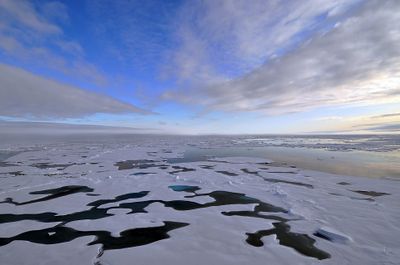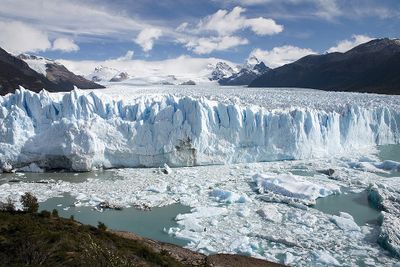Land vs sea ice
Land ice and sea ice comprise the majority of the polar regions on Earth. This article is aimed to distinguish between these two types of ice.
The most basic difference is that sea ice forms from salty ocean water, whereas land ice (ice sheets and glaciers) form from fresh water or snow. Land ice can be labelled as ice sheets whereas sea ice can be labelled as ice shelves.[1] They vary greatly in quantity due to seasonal changes in temperature. An increase in global temperature caused by anthropogenic warming influences the quantity of polar ice.[1]
Sea Ice

Sea ice forms in the winter months and melts in the summer months, however in certain regions it remains year round. Roughly 15% of the world's oceans are covered by sea ice during a portion of the year.[3]
Sea ice is white which means it has a highly reflective surface, thus it has a high albedo.[4] Roughly 80% of the sunlight that hits the ice reflects into space. As the sea ice melts in the summer, and instead of reflecting, the ocean absorbs 90% of the sunlight. This absorption heats up the ocean causing further more melting of ice.[5] This is an example of a positive climate feedback, which is part of why climate change effects are hard to predict.
Both types of ice range over vast areas of the polar regions. Global sea ice on average covers nearly 25 million km2, the same size as the North American continent.[6]
Land Ice

Glaciers are land ice. Which can become sea ice when chunks of ice that break off and fall into the ocean (and become icebergs). Lake ice is also considered land ice. Frigid, low density fresh water stays at the surface of a lake or river, forming a layer of ice on the surface.[1] Land ice differs from sea ice in the way that it is formed. Fresh water becomes less dense as it approaches the freezing point.[1] In contrast, sea ice forms quite slowly, compared to freshwater ice, because the saline water tends to sinks away from the cold surface before it cools enough to solidify. Ice sheets and glaciers cover approximately 15 million km2, roughly equivalent to 10% of the Earth's land surface area.[1] While still large, land ice only covers two thirds as much surface area as sea ice covers.
Consequences of Melting
As ice melts and becomes water, the volume of water gets displaced relative to the volume of water it would contribute as melting occurs. Thus, when sea ice, there is no change in sea level rise.[1] This is due to Archimedes' principle which states that if a body is immersed in a fluid, that body is lifted up by a buoyant forces equal to the weight of the fluid that is displaced. With land ice, the ice wasn't displacing any water. When the land ice melts, additional water is added into the ocean, causing the sea level to rise.[1]
The intensity of sea level rise depends on the quantity of melt occurring. For example, if the entire West Antarctic ice sheet melted, the sea level would increase by 5 meters.[1] To put that into perspective, a 1-meter level sea rise would displace 100 million people who live along coastal lines.[1] Ice shelves act as a reinforcement, preventing glacial ice from reaching the ocean. Once the barrier is gone, glacial ice melt entering the ocean would increase the sea level.[1] Greenland and Antarctica combined, contain about 75% of the world's fresh water, which is enough to raise sea level by over 75 meters, if all the ice were restored to the oceans.[1]
There are more consequences than just sea level rise to due land and sea ice melting. Differences in salinity and temperature impact global ocean circulation.[1] These variations in ocean temperature and salinity can disrupt and threaten marine species that are dependent on the ocean due to the ocean being delicate to change. Fresh water is less dense than salt water and warm water is less dense than cold water; these differences cause circulation in the ocean which is referred to as thermohaline circulation.
References
- ↑ 1.00 1.01 1.02 1.03 1.04 1.05 1.06 1.07 1.08 1.09 1.10 1.11 "Ice Shelf and Ice Sheet Simulation", National Science Foundation - PBS LearningMedia. [Online]. Available: http://www.pbslearningmedia.org/resource/ipy07.sci.ess.watcyc.icesimulate/ice-shelf-and-ice-sheet-simulation/#support-materials.
- ↑ PixaBay. (May 8, 2016). ‘’Arctic Ocean Sea Ice’’ [Online]. Available: https://pixabay.com/static/uploads/photo/2016/03/14/15/46/arctic-ocean-1255679_960_720.jpg
- ↑ ”All About Sea Ice | All About Sea Ice | National Snow and Ice Data Center", National Snow & Ice Data Center, 2016. [Online]. Available: http://nsidc.org/cryosphere/seaice/index.html. [Accessed: 07- May- 2016].
- ↑ ”All About Sea Ice | Environment : Climate | National Snow and Ice Data Center", National Snow & Ice Data Center, 2016. [Online]. Available: http://nsidc.org/cryosphere/seaice/environment/global_climate.html. [Accessed: 08- May- 2016].
- ↑ ”Quick Facts | Quick Facts on Arctic Sea Ice | National Snow and Ice Data Center", National Snow & Ice Data Center, 2016. [Online]. Available: http://nsidc.org/cryosphere/quickfacts/seaice.html. [Accessed: 08- May- 2016].
- ↑ ”Polar Ice Fact Sheet : Feature Articles", NASA, 2016. [Online]. Available: http://earthobservatory.nasa.gov/Features/PolarIce/polar_ice.php. [Accessed: 08- May- 2016].
- ↑ PixaBay. (May 8, 2016). ‘’Glacial Ice Argentina’’ [Online]. Available:https://pixabay.com/static/uploads/photo/2012/12/22/23/37/argentina-71909_960_720.jpg

